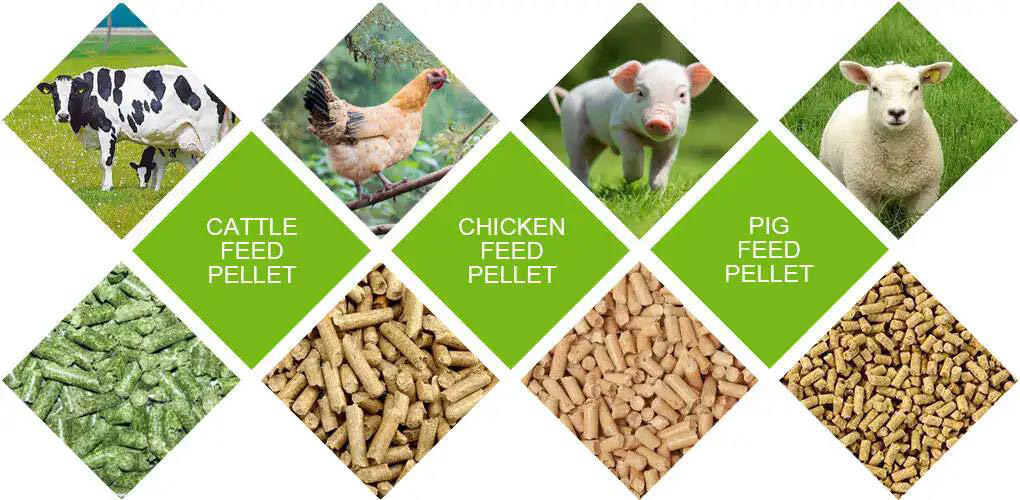livestock feed plant
A livestock feed plant is a facility or enterprise specialized in producing feed for livestock such as cattle, sheep, and pigs. These factories process and formulate various ingredients (such as grains, legumes, protein sources, vitamins, and minerals) to produce feed products that meet the nutritional requirements of livestock.
livestock feed plant Introduction
A livestock feed plant is a facility or enterprise specialized in producing feed for livestock such as cattle, sheep, and pigs. These factories process and formulate various ingredients (such as grains, legumes, protein sources, vitamins, and minerals) to produce feed products that meet the nutritional requirements of livestock. livestock feed plant typically have advanced equipment and technology to ensure the production of high-quality, nutritionally balanced feed, meeting the nutritional needs for the growth, production, and health of livestock. These factories play a crucial role in the livestock farming industry by providing quality feed products to farmers, thus promoting the healthy development of the livestock farming industry.


Characteristics of livestock feed plant
Focus on livestock feed production
These plants specialize in producing feed for livestock such as cattle, sheep, and pigs, aiming to provide high-quality feed products.
Scientific formulation of nutrition
Livestock feed plants formulate feed scientifically based on the nutritional requirements of different types of livestock and their growth stages, ensuring balanced nutrition in the feed.
Raw material processing capability
They have the ability to process various ingredients through mixing, grinding, pelleting, etc., to produce feed products suitable for digestion and absorption by livestock.
Quality control system
They establish strict quality control systems to comprehensively monitor and test raw material procurement, production processes, and finished products, ensuring stable product quality.
Technological advancement
They possess advanced production equipment and processing technology to enhance production efficiency and product quality.
Market orientation
They adjust production scale and product structure according to the needs of the livestock farming industry to meet market demands.
Comprehensive after-sales service
They provide professional after-sales services, including technical support, consultation, and product services, to ensure customer satisfaction and product quality.


livestock feed plant process flow
Raw material procurement
Procuring raw materials such as grains, legumes, protein sources, vitamins, and minerals from reliable suppliers.
Raw material storage
Storing the purchased raw materials in appropriate warehouses or storage facilities for subsequent use.
Raw material preprocessing
Preprocessing the raw materials through cleaning, sorting, grinding, and mixing to achieve the desired particle size and composition.
Feed formulation
Formulating the feed by combining different preprocessed ingredients according to specific nutritional requirements and proportions for different types of livestock.
Mixing
Thoroughly mixing the formulated feed ingredients to ensure uniform distribution of nutrients throughout the feed mixture.
Pelleting
Pelleting the mixed feed to form pellets of uniform size and shape, which enhances feed palatability and facilitates handling and storage.
Drying
Drying the pelleted feed to reduce moisture content and improve shelf life and storage stability.
Cooling
Cooling the dried pellets to room temperature to prevent heat damage and ensure product quality.
Packaging
Packaging the finished feed products into bags, sacks, or bulk containers, ready for distribution and sale.
Quality control
Implementing quality control measures throughout the production process to ensure the final feed products meet nutritional requirements and quality standards.

Advantages of livestock feed plant
High-quality feed products
Livestock feed plants can produce high-quality, nutritionally rich feed to meet the nutritional needs of different types of livestock, promoting their growth and health.
Scientific formulation of nutrition
Through scientific formulation, livestock feed plants can ensure balanced nutrition in the feed, enhancing feed utilization and production efficiency.
Advanced production equipment and technology
Livestock feed plants are typically equipped with advanced production equipment and processing technology, enabling them to improve production efficiency and product quality.
Rigorous quality control system
Establishing a strict quality control system, livestock feed plants comprehensively monitor and test raw material procurement, production processes, and finished products to ensure product safety and stability.
Flexible production capacity
Livestock feed plants have flexible production capacity, allowing them to adjust production scale and product structure according to market demand, meeting the needs of different customers.
Customized customer service
Providing customized feed formulations and production services according to customer-specific needs and requirements enhances customer satisfaction and loyalty.
Comprehensive after-sales service
Offering professional after-sales services, including technical support, consultation services, and product after-sales services, provides customers with comprehensive support and services.
Application of livestock feed plant
Typically, the production of animal feed processing plant uses raw materials such as corn, soybeans, wheat, and other nutrients as the formula. Our small feed mill plants are specially used to produce feed for poultry, livestock, pigs, horses, cattle, sheep, chickens, ducks, goose and other animals.For different animals, with different growth cycles, (chicks, suckling pigs, calves, etc.), the feed pellet size required is different, but our feed production line only needs to replace ring molds with different apertures or use a pellet crumbler to reach the required size.

Parameter of livestock feed plant
| Model | Capacity | Main Motor Power | Feeder Motor Power | Conditioner Power | Dia. of Ring Die | Pellet Size |
| SZLH250 | 1-2T/H | 22KW | 0.75kw | 1.5kw | 250mm | 2-12mm |
| SZLH320 | 3-4T/H | 37KW | 1.5kw | 2.2kw | 320mm | 2-12mm |
| SZLH350 | 5-7T/H | 55KW | 1.5kw | 3kw | 350mm | 2-12mm |
| SZLH420 | 8-12T/H | 110KW | 1.5kw | 7.5kw | 420mm | 2-12mm |
| SZLH508 | 10-18T/H | 160KW | 2.2kw | 11kw | 508mm | 2-12mm |
| SZLH558 | 15-25T/H | 180KW | 2.2kw | 11kw | 558mm | 2-12mm |
| SZLH678 | 20-30T/H | 220KW | 2.2kw | 11kw | 678mm | 2-12mm |
| SZLH768 | 25-42T/H | 280KW | 2.2kw | 11kw | 768mm | 2-12mm |







